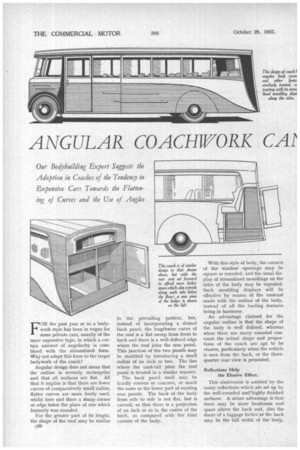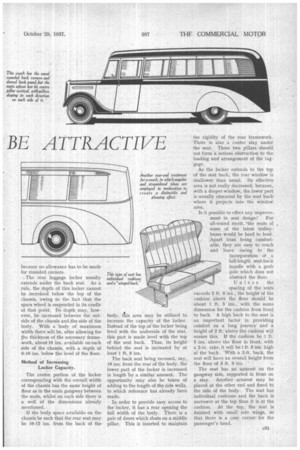ANGULAR COACIIVOKK CAP BE ATTRACTIVE
Page 112

Page 113

If you've noticed an error in this article please click here to report it so we can fix it.
Our Bodybuilding Expert Suggests the Adoption in Coaches of the Tendency in Expensive Cars Towards the Flattening of Curves and the Use of Angles
FOR the past year or so a bodywork style has been in vogue for some private cars, usually of the more expensive type, in which a certain amount of angularity is combined with the streamlined form. Why not adapt this form to the larger bodywork of the coach?
Angular design does not mean that the outline is severely rectangular and that all surfaces are flat. All that it implies is that there are fewer curves of comparatively small radius, flatter curves are more freely used, whilst here and there a sharp corner or edge takes the place of one which formerly was rounded.
For the greater part of its length, the shape of the roof may be similar c50 to the prevailing pattern, but, instead of incorporating a domed back panel, the lengthwise curve of the roof is a flat sweep from front to back and there is a well-defined edge where the roof joins the rear panel. This junction of the two panels may be modified by introducing a small radius of an inch or two. The line where the cant-rail joins the roof panel is treated in a similar manner.
The back panel itself may be faintly convex or concave, or much the same as the lower part of existing rear panels. The back of the body from side to side is not flat, but is curved, so that there is a projection of an inch or so in the centre of the back, as compared with the hind corners of the body. With this style of body, the corners of the window openings may be square or rounded, and the usual display of streamlined mouldings on the sides of the body may be repeated. Such moulding displays will be effective by reason of the contrast made with the outline of the body, instead of all the leading features being in harmony.
An advantage claimed for the angular outline is that the shape of the body is well defined, whereas when there are many rounded contours the actual shape and proportions of the coach are apt to be elusive, particularly when the vehicle is seen from the back, or the threequarter rear view is presented.
Reflections Help the Elusive Effect.
This elusiveness is assisted by the many reflections which are set up by the well-rounded andlaighly finished surfaces. A minor advantage is that there may be more headroom and space above the back seat, also the doors of a luggage locker at the back may be the full width of the' body, because no allowance has to be made for rounded corners.
The rear luggage locker usually extends under the back seat. As a rule, the depth of this locker cannot be increased below the top of the chassis, owing to the fact that the spare wheel is suspended in its cradle at that point. Its depth may, however, be increased between the outside of the chassis and .the side of the body. With a body of maximum width there will be, after allowing for the thickness of the necessary framework, about 16 ins, available on each side of the chassis, with a depth of 9-10 ins, below the level of the floor.
Method of Increasing Locker Capacity.
The centre portion of the locker corresponding with the overall width of the chassis has the same height of floor as in the main gangway between the seats, whilst on each side there is a well of the dimensions already mentioned.
If the body space available on the chassis be such that the rear seat may be 10-12 ins, from the back of the body, ttis area may be utilized to increase the capacity of the locker. Instead of the top of the locker being level with the underside of the seat, this part is made level with the top of the seat back. Thus, its height behind the seat is increased by at least 1 ft. 8 ins.
The back seat being recessed, say, 10 ins, from the rear of the body, the lower part of the locker is increased in length 'by a similar amount. The opportunity may also be taken of adding to the length of the side wells, to which reference has already been made.
In order to provide easy access to the locker, it has a rear opening the full width of the body. There is a pair of doors which shuts on a middle pillar. This is inserted to maintain
the rigidity of the rear framework. There is also a centre stay under the seat. These two pillars should not form a serious obstruction to the loading and arrangement of the luggage.
As the locker extends to the top of the seat back, the rear window is shallower than usual. Its effective area is not really decreased, because, with a deeper window, the lower part is usually obscured by the seat back where it projects into the window area.
Is it possible to effect any improvement in seat design? For all-round merit, the seats of some of the latest trolleybuses would be hard to beat. Apart from being comfortable, they are easy to reach and leave Owing to the incorporation of _a full-length seat-back handle with a grab pole which does not obstruct the floor.
Unless the spacing of the seats exceeds 2 ft. 6 ins., the height of the cushion above the floor should be about 1 ft. 5 ins., with the same dimension for the cushion from front to back. A high back to the seat is an important factor in providing comfort on a long journey and a height of 2 ft. above the cushion will ensure this. If the cushion be 1 ft. 5 ins, above the floor in front, with a 2-in, rake, it will be 1 ft. 3 ins, high at the back. With a 2-ft. back, the seat will have an overall height from the floor of 3 ft. 3 ins..
The seat has an armrest on the gangway side, supported in front on a stay. Another armrest may be placed at the other end and fixed to the side of the body. The seat has individual cushions and the back is narrower at the top than it is at the cushion. At the top, the seat is finished with small side wings, so that there is a cosy corner for the passenger's head.
























































































































































































